Pilot Briefing: Diamond DA50 turboprop enters flight testing
Airframe development began nine years ago
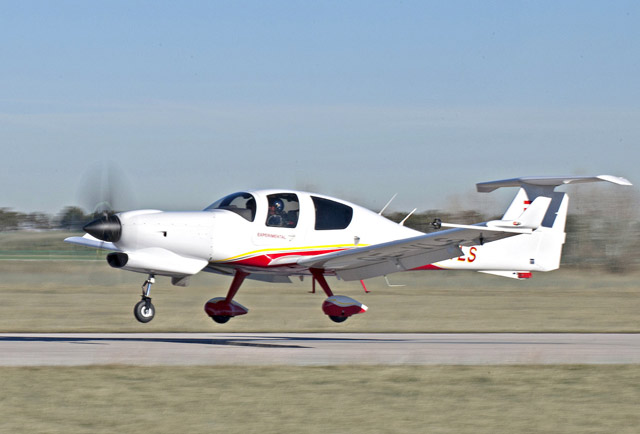
By Alton K. Marsh
Flight testing of a seven-place Diamond Aircraft DA50-JP7 powered by a turboprop engine built in Ukraine is in progress in Austria. The aircraft was first announced at Germany’s Aero Friedrichshafen trade show in 2013. Additional information will be released at that show April 15, 2015. The concept has been tested since 2006 with gasoline and diesel engines.
The aircraft completed its first flight in January at Wiener Neustadt, Austria, with Diamond Aircraft CEO Christian Dries and test pilot Ingmar Mayerbuch aboard. Afterward Dries declared the aircraft to fly like “a rocket.”
The airplane will be manufactured in two versions—“Tundra” and consumer versions. The Tundra will have oversize tires and rugged landing gear for rough terrain. The second version is aimed at the high-performance training market and private owners.
The 465-horsepower AI-450S turbine engine is built by Ukrainian company Motor Sich JSC in collaboration with Ivchenko Progress. Diamond officials claim a 20-percent lower fuel burn than similar turbine engines. The aircraft has full authority digital engine controls, meaning a lighter pilot workload. The engine start sequence begins with the push of a single button. The aircraft will be built at Diamond Aircraft headquarters in Wiener Neustadt, where another Diamond company—Austro Engine—is located. Austro is involved in certifying and later overhauling the DA50 engine.
Email [email protected]
DA50 prototypes
• Five-seat unpressurized, 150-knot Austro diesel-engine DA50 Magnum ($700,000)
• Five-seat pressurized DA50 Superstar with a Continental 550 engine ($650,000)
• DA50 projects were put on hold in 2009.
• It continues to be a development project, including the current turboprop.
• The DA50 fuselage was used for the DA62 twin that may be certified this year.
Awards: Endeavor Awards back for second year
Celebrating public benefit flying
By Julie Summers Walker
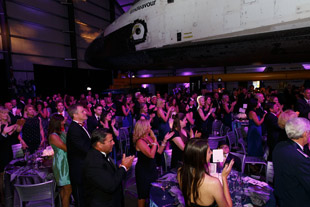 A star-studded evening celebrating the contributions of public benefit flying was a highlight of the aviation community in 2014 and the event was so successful and inspiring, it returns this May 30. The brainchild of Hollywood producer and GA pilot Mark Wolper, the Endeavor Awards honors the pilots and organizations that provide assistance through aviation to those in need. Last year’s recipients included pilots from the Veterans Airlift Command, Wings Flights of Hope, and Patient Airlift Services.
A star-studded evening celebrating the contributions of public benefit flying was a highlight of the aviation community in 2014 and the event was so successful and inspiring, it returns this May 30. The brainchild of Hollywood producer and GA pilot Mark Wolper, the Endeavor Awards honors the pilots and organizations that provide assistance through aviation to those in need. Last year’s recipients included pilots from the Veterans Airlift Command, Wings Flights of Hope, and Patient Airlift Services.
The three recipients this year will be awarded $15,000; their names will be announced prior to the event. Two Inspirational Awards will be presented to Global Flight Relief, an organization led by Ben Affleck and Scott Terry in the East Congo; and to Clay Lacey, an aviation legend and inspiration in aviation and film.
The Endeavor Awards take place at the California Science Center in Los Angeles, in the room that houses the Space Shuttle Endeavor. Guests dine under the wings of the massive spacecraft.
Email [email protected]
HAI announces winners of Salute to Excellence Awards
The Helicopter Association International recently announced recipients of its acclaimed Salute to Excellence Awards:
Lightspeed Aviation Excellence in Communications Award: Michael Hirschberg, executive director of AHS International and editor of Vertiflite.
W.A. “Dub” Blessing Award for CFI of the Year: Simon Spencer-Bower, Wanaka Helicopters in Central Otago, New Zealand.
Excellence in Helicopter Maintenance Award: Patrick Cox, director of product support for Robinson Helicopter Corp.
MD Helicopters Law Enforcement Award: U.S. Park Police “Eagle 1” aviation unit for its response to the shootings at the Naval Yard in Washington, D.C.
Airbus Helicopters Gold Hour Award: Snohomish Co. Helicopter Rescue Team for its response in the Washington Cascade Mountains.
Excellence in Safety Award: Edwin McConkey, mathematician and software engineer who developed the criteria and algorithm for helicopter-specific instrument approaches.
Sikorsky Humanitarian Service Award: Portuguese Air Force 751 Squadron, for its search-and-rescue missions in a 2.3-million-square-mile portion of the Atlantic Ocean.
Appareo Systems Pilot of the Year Award: Gary Dahlen, for his response to California’s King Fire.
Bell Helicopter Lifetime Achievement Award: Lou Bartolotta
The awards were to be presented at HAI Heli-Expo 2015 in Orlando March 2-5.
Harrison Ford honors AOPA
President Mark Baker receives Legacy in Aviation Award
By Steve Schapiro
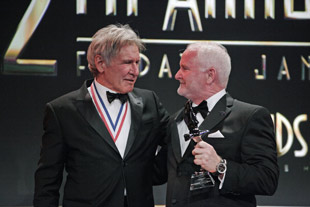 On a night when Hollywood stars and aviation luminaries came together to celebrate the wonder of flight, AOPA President Mark Baker was honored with the Harrison Ford Legacy in Aviation Award at the twelfth annual Living Legends of Aviation Awards.
On a night when Hollywood stars and aviation luminaries came together to celebrate the wonder of flight, AOPA President Mark Baker was honored with the Harrison Ford Legacy in Aviation Award at the twelfth annual Living Legends of Aviation Awards.
“It’s obviously a very proud moment to have that kind of recognition,” Baker said. The award is named for the actor who has served as a spokesman for AOPA’s GA Serves America campaign and as chairman of EAA’s Young Eagles Program.
“Any time you can bring a spotlight to aviation and what it can do for people is healthy,” Baker said. “I like to believe this [award] reminds them [attendees] how important this organization is and that it represents the largest part of general aviation by far. It’s about the importance of having an AOPA since 1939 and protecting the freedom of flying.”
There are 89 “Living Legends of Aviation” who have been recognized for their outstanding accomplishments and contributions to aviation. The event is produced by Kiddie Hawk Air Academy, a nonprofit organization that introduces children ages 5 through 11 to flight through the Kiddie Hawk Trainer.
The event is considered the Academy Awards of aviation. It is held at the Beverly Hilton, which hosted the Golden Globe Awards a few days earlier, and the Living Legends honors the remarkable accomplishments made by aviation and aerospace entrepreneurs, industry leaders, innovators, record breakers, astronauts, and pilots who have become celebrities as well as celebrities who have become pilots.
Harrison Ford presented what he called “the awkwardly named” award to Baker, whom he has known through their work to preserve California’s Santa Monica Municipal Airport, as well as flying the backcountry together. Ford spoke of how aviation has made an extraordinary contribution to our nation, but it is in jeopardy.
“We are in danger of losing the gains that we have made in aviation, especially in the general aviation area,” Ford said. “The recipient of this year’s award is in a position to do something very constructive about that. Mark Baker is a longtime pilot, new president of AOPA, and has the opportunity, the wit, and the capacity to make a great contribution to the aviation community in the general aviation area.”
The evening began with John Travolta, host of the event, inducting three new Living Legends—Southwest Airlines founder and former CEO Herb Kelleher, who also was recognized with the Lifetime Aviation Entrepreneur Award; FlightSafety International President, CEO, and Chairman Bruce Whitman; and Maj. Gen. Carl McNair (Ret.), a decorated combat helicopter pilot who directed and oversaw the Army’s Aviation Branch.
Louis Zamperini—the Olympic runner, B–24 bombardier, and POW who inspired the book and movie Unbroken—was named an honorary Legend.
Other award winners included Michimasa Fujino, founding president and CEO of Honda Aircraft Co., who was recognized as the Aviation Industry Leader of the Year; and Elling Halvorson, chairman of Papillon Grand Canyon Helicopters, who was honored with the Vertical Flight Hall of Fame Award for his pioneering efforts in the helicopter tour industry.
Terrafugia requests weight and stall speed increases
FAA consideration could take a year
By Alton K. Marsh
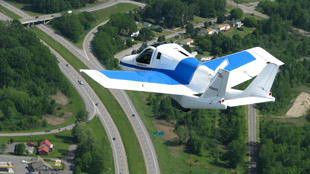 Terrafugia of Woburn, Massachusetts, has requested a second exemption from the FAA for its two-place Transition flying car. A previous exemption in 2010 allowed the air-car to increase weight from the Light Sport standard of 1,320 pounds for land aircraft to 1,430 pounds. The latter weight is the standard for Light Sport seaplanes. The company bases its request on the grounds that meeting highway safety standards ultimately makes the aircraft more crashworthy.
Terrafugia of Woburn, Massachusetts, has requested a second exemption from the FAA for its two-place Transition flying car. A previous exemption in 2010 allowed the air-car to increase weight from the Light Sport standard of 1,320 pounds for land aircraft to 1,430 pounds. The latter weight is the standard for Light Sport seaplanes. The company bases its request on the grounds that meeting highway safety standards ultimately makes the aircraft more crashworthy.
The new exemption request takes the weight to 1,800 pounds, mostly to allow systems that meet federal highway standards, and also asks for an increase in stall speed from the present LSA standard of 45 knots calibrated airspeed to 54 knots.
Terrafugia CEO and co-founder Carl Dietrich said he is “cautiously optimistic” that the exemption will be granted. Approval under the LSA rule, where standards are set by industry consensus, will allow faster approval than is the case if the company is required to opt for Primary category certification. Disapproval of the exemption request would mean certification under Primary category rules, resulting in higher certification costs and lengthen the time required for certification, Dietrich said. Whether the exemption is approved or not, the aircraft will need to weigh 1,800 pounds, he said. He did not offer a guess as to the increase in certification costs or sales price if the aircraft is certified in the Primary category. The first six aircraft will be sold for $299,000. After that price will be re-evaluated.
The greatest weight increase came from the need for “roadability” systems, adding a total of 266 pounds to the aircraft. In that category, ground handling—to include steering, suspension, and braking— added 150 pounds. Occupant structural protection added 69 pounds, while non-structural occupant protection added 52 pounds. The ballistic recovery parachute adds 36 pounds. The company included a “contingency” allowance of 57 pounds.
Web: www.terrafugia.com
Email [email protected]
AOPA has told the FAA it supports Terrafugia’s request for a weight exemption, because the association sees value in the program. “Allowing such an interesting new design has the potential to inspire and bring more people into general aviation,” said Rob Hackman, AOPA vice president of regulatory affairs.
How does it work?
The Transition converts to an aircraft when the occupant stops the vehicle and throws switches to electrically unfold and lock the wings. The process is verified by computer. “Due to the location of the rear wheels (further aft of the center of gravity than most other LSAs), the Transition cannot rotate for takeoff until there is more than adequate airspeed for flight,” the exemption request states. It will have a longer-than-normal landing roll for a Light Sport aircraft. In flight the aircraft is controlled by a stick, rudder pedals, and a throttle. On the ground it is driven with a steering wheel plus gas and brake pedals.
Belgium firm offers Light Sport engine
Hopes to compete with Rotax
By Alton K. Marsh
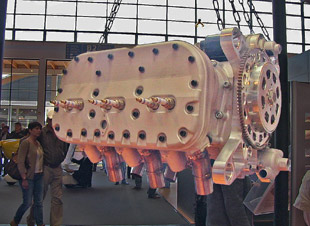 Competition is coming from Belgium for the popular Rotax seen in many Light Sport aircraft. A four-cylinder side valve engine from D-Motor near Brussells, Belgium, is entering the United States market through its distributor, Renegade Light Sport in Deland, Florida.
Competition is coming from Belgium for the popular Rotax seen in many Light Sport aircraft. A four-cylinder side valve engine from D-Motor near Brussells, Belgium, is entering the United States market through its distributor, Renegade Light Sport in Deland, Florida.
It is an old design seen in cars in the United States in the 1950s, but has been adapted for use in aircraft. The first offering will be a liquid-cooled 92-horsepower LF26 $18,500 model. In the works is a six-cylinder LF39 model that can generate a maximum of 130 horsepower. It will be certified by mid to late 2015.
The engine is in testing at Renegade for certification to ASTM standards used by this country’s LSA industry. It is flying on several aircraft around the world. The flat head design makes the engine smaller. It operates at lower rpm than a Rotax engine and will cruise at 2,800 rpm. It has been in testing in Belgium since 2010. The website (dmotorusa.com), describes the engine as a four-stroke, side-valve (flat head) boxer engine. It is upgraded from the old design with multipoint fuel injection, electronic ignition, and liquid cooling. The site claims the direct-drive motor is simpler because it “doesn’t have the complexity of rockers.”
Renegade offers the Renegade Carbon Lil Rascal biplane, the Renegade Falcon LS 2.0 low-wing aircraft, and the Renegade Falcon LS 2.0 Mizzoura Taildragger. Both Renegade Falcon models can withstand plus 6 Gs and minus 3 Gs.
Email [email protected]
By the numbers
LF26
Weight 123 pounds dry, 139 pounds wet
Max power 93 horsepower at 3,000 rpm
Max continuous power 89 horsepower at 2,800 rpm
Cost $18,500
Displacement 2,690 cc
LF39
Weight 171 pounds dry, 187 pounds wet
Max power 130 horsepower at 3,000 rpm
Max continuous power 125 horsepower at 2,800 rpm
Cost not determined
Displacement 3,993 cc
Fuel 95-98 octane or avgas
Cub pilot conquers the peaks
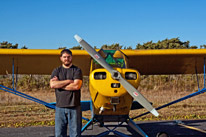 Garrett Fisher is an example of a pilot who knows his mission and uses the exact aircraft needed. Using the Piper Cub Special PA–11 in which he soloed in 1997, Fisher photographed Colorado’s 14 peaks and wrote Above the Summit: An Antique Airplane Conquers Colorado’s Fourteeners, available at amazon.com.Fisher admits mountain flying scared him, not to mention froze him at minus 20 degrees. F, for good reason. “Maximum drama was a rotor on takeoff at 200 feet above ground level at Leadville (descending at 38 mph indicated, full power), a momentarily sputtering engine at 14,000 feet, and getting knocked [into] 60 degrees bank twice while in cruise flight (safely from terrain) due to upper level winds interacting with terrain,” Fisher said. (See Fisher’s “Never Again” story on page 92.) —AKM
Garrett Fisher is an example of a pilot who knows his mission and uses the exact aircraft needed. Using the Piper Cub Special PA–11 in which he soloed in 1997, Fisher photographed Colorado’s 14 peaks and wrote Above the Summit: An Antique Airplane Conquers Colorado’s Fourteeners, available at amazon.com.Fisher admits mountain flying scared him, not to mention froze him at minus 20 degrees. F, for good reason. “Maximum drama was a rotor on takeoff at 200 feet above ground level at Leadville (descending at 38 mph indicated, full power), a momentarily sputtering engine at 14,000 feet, and getting knocked [into] 60 degrees bank twice while in cruise flight (safely from terrain) due to upper level winds interacting with terrain,” Fisher said. (See Fisher’s “Never Again” story on page 92.) —AKM
Web: www.garrettfisher.me
Two aircraft ditch in Pacific
Coast Guard video shows Cirrus chute deployment
By Alton K. Marsh
 A Cirrus SR22 making a 2,102-nautical-mile ferry flight from Tracy, California, to Kahului, Hawaii, developed fuel system problems and deployed the airframe parachute 219 nm short of its goal. A Coast Guard HC–130, in radio contact with pilot Louis E. Morton of Seattle, captured the descent and splashdown with an infrared camera. A short time later that same HC–130 was sent to aid in the ocean ditching of a Cessna 172 that ran out of fuel returning to Honolulu from Lihue, 93 nm away.
A Cirrus SR22 making a 2,102-nautical-mile ferry flight from Tracy, California, to Kahului, Hawaii, developed fuel system problems and deployed the airframe parachute 219 nm short of its goal. A Coast Guard HC–130, in radio contact with pilot Louis E. Morton of Seattle, captured the descent and splashdown with an infrared camera. A short time later that same HC–130 was sent to aid in the ocean ditching of a Cessna 172 that ran out of fuel returning to Honolulu from Lihue, 93 nm away.
Morton’s Cirrus had been outfitted with extra fuel tanks for the flight to Hawaii. He was conducting the flight for The Flight Academy in Seattle, which specializes in Cirrus instruction and lists ferry flights as one of its services. There were fuel-flow problems that the pilot tried to fix. When he couldn’t, he contacted San Francisco ARINC by satellite phone to report the problem. Oakland Center then contacted the Coast Guard, which alerted the Barbers Point Coast Guard Station.
Morton had high praise for the coordination offered by San Francisco ARINC, the Coast Guard, and Holland America—which sent its ship, the Veendam, to pick him up. Morton flew to the ship and deployed his airframe parachute near it. Seas were reported to be nine to 12 feet with 28-knot winds. The ship dispatched a lifeboat and had him on board within 30 minutes of splashdown. The cruise line continued to Maui, feeding Morton and letting him get some rest.
As the HC–130 was returning to U.S. Coast Guard Air Station Barbers Point, it was diverted to a Cessna 172 that was running out of fuel with three adults and a baby onboard. The aircraft safely ditched 11 miles west of Oahu and there were no injuries. The survivors were hoisted to a Coast Guard MH–65 Dolphin helicopter. Two Coast Guard ships were also dispatched to the scene.
Email [email protected]
Air Shepherd targets poachers
Unmanned systems guided by ‘big data’
By Jim Moore
Illegal poaching, fueled by the burgeoning demand for ivory, threatens the existence of African elephants, a species that could be wiped out earlier than was first estimated by some as recently as 2014. Rhinoceros populations face similar peril, and the wild populations are a fraction of the size.
Air Shepherd, a nonprofit organization created by the Charles A. and Anne Morrow Lindbergh Foundation, joined the effort to supply Africa’s rangers and wildlife guardians with aerial solutions, but it has something that others do not—University of Maryland professor Thomas Snitch and his invention, a tool to analyze data and predict where poachers will strike next.
Snitch developed this use of “big data” (large-scale data collection and analysis), to find bombs in Iraq and Afghanistan before they harmed American troops—and to also track down those who planted the devices. Snitch realized that the same approach, with a few adjustments, could work just as well finding poachers—even before they make their kills.
Lindbergh Foundation Chairman John Petersen has been working behind the scenes to enlist high-profile celebrity support for the Air Shepherd campaign, which seeks donations and to replicate what Snitch and his team have accomplished on a thus-far limited basis in South Africa. “They have flown over 350 missions,” Petersen said, referring to three years of small-scale operations by Snitch and local operators in South Africa, and “not one rhino has been killed at any time and place they’ve been flying. We know that it works.”
The unmanned systems initially were greeted with suspicion by African rangers, Snitch said. The government agents tasked with protecting wildlife were concerned the small aircraft would replace them. The benefits soon became obvious enough to win them over: “We will see if there’s anyone hiding in the bushes waiting to kill you.”
Snitch said the same technology has other potential applications, including search and rescue. The technology could also boost tourism, which so many countries depend on to finance government operations including conservation. First, though, there is the increasingly urgent task of protecting the wildlife—elephants and rhinoceros in particular—which draws so many of the tourists.
Email [email protected]
Web: www.lindberghfoundation.org
Over the poles
Bill Harrelson sets ‘bipolar’ speed record
By Dan Namowitz and Dave Hirschman
Flying an Experimental Lancair IV that he and wife Sue built at their Fredericksburg, Virginia, home, Bill Harrelson completed an around-the-world solo flight over both poles that appears to have set a new world record for aircraft under 3,000 kilograms.
Harrelson completed the perilous journey in 24 days, the culmination of more than a decade of studying, planning, and building. Along the way, he encountered airframe ice, extreme heat and cold, equipment failures, regulatory burdens, and severe headwinds that forced last-minute route changes.
“I wanted to see if it was possible for a regular person to set a meaningful world aviation record without major corporate backing, or deep pockets of his own,” said Harrelson, 64, a retired airline pilot. “It turns out, it can be done.”
Harrelson left Kinston, North Carolina, in his highly specialized aircraft that contains 10 fuel tanks and can hold up to 361 gallons of avgas. He flew south to southern Chile and made it over the South Pole before headwinds and the threat of airframe ice forced him to return to South America. (When an autopilot servo broke near the South Pole, he hand-flew in pitch for 14 hours). He was delayed for three days by Tahiti’s refusal of his flight plan, but made it there before pressing on to New Zealand, Hawaii, California, and Alaska.
A non-stop flight from Fairbanks, then over the North Pole, and on to his North Carolina starting point on January 21 appears to have shattered the previous world record of four months set by Richard D. Norton in a Piper PA–46 Malibu.
Some high points for Harrelson include seeing the coastal mountains of Antarctica tower more than 12,000 feet above the ocean surface; the South Pole, which resembles “a junkyard at the end of the world;” colorful South Pacific archipelagos, and the winter sun rising and setting within minutes near the Arctic Circle.
Cockpit temperatures fell into the single digits on the dark, North Pole leg, and outside air temperatures as low as minus 38 degrees C caused the engine oil temperature to drop to 70 degrees F.
Harrelson logged about 175 flight hours on the trip over some of the world’s harshest and least accessible places.
“I was petrified by ice, and I encountered it near South America,” he said. (His Lancair has no deice or anti-ice systems.)
Harrelson previously set a category world distance record for a non-stop flight from Guam to Jacksonville, Florida, but said the double polar flight is his last one.
“I’d like to go back to New Zealand and some of the other places I visited on this trip,” he said. “But next time Sue (who is also a retired airline pilot) is coming with me. And we’re not going to be in a hurry.”
The Ercoupe project that grew and grew
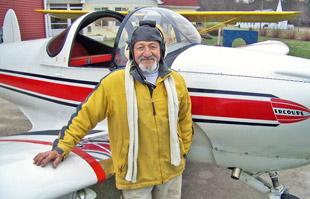 The good news is that John Chirtea knows more about his Ercoupe than most aircraft owners will ever know. The downside is that he has invested $15,000 in the aircraft after discovering problems after a purchase that didn’t include a pre-buy inspection. He’s justly proud of the result.
The good news is that John Chirtea knows more about his Ercoupe than most aircraft owners will ever know. The downside is that he has invested $15,000 in the aircraft after discovering problems after a purchase that didn’t include a pre-buy inspection. He’s justly proud of the result.
He’s replaced the fuel tanks and gas lines, bought new magnetos, overhauled the electrical system to include all-new wiring, and replaced the brakes. The panel is now vinyl teak over aluminum, but the leather cover on top still needs to be replaced with carpet. He jokes that he had some money in his pocket and snapped up the Florida airplane as soon as he saw it.
“It is almost worth it when my mechanic makes the comment that the Coup doesn’t fly, it dances! I can now add this to my current flying ‘fleet,’ which includes a 1946 Aeronca Champ 7DC, and a Fisher Flying Products Celebrity with
a Rotec R2800 radial engine. The Champ is the actual plane in which I took my first lesson in December 1955,” the Milton, Delaware, pilot said. —AKM
Older diesel engine gets another look
From the fertile mind of Robert McCulloch (1911-1977) came the McCulloch chainsaw company, Lake Havasu City (he was the founder), the purchase of the old London Bridge, and a lightweight diesel aircraft engine. Now mechanical engineer Joe Crover and his father, also a mechanical engineer, have patented technologies to make the McCulloch dream come true.
Their effort has just started, and it will be years before a five-cylinder, 180-horsepower radial diesel engine could be ready. To get started the two obtained McCulloch’s similar engine that burns gasoline, the five-cylinder TSIR-5190, and ran it for study in early 2014. Two museum copies of the TRAD-4180 diesel engine are incomplete. The goal, Crover said from his home in Gresham, Oregon, is a less expensive diesel engine. Development could take five years if funding is located (www.croverdiesel.com). —AKM
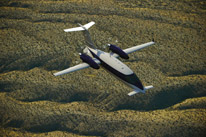
Avanti Evo deliveries begin
Deliveries have begun in Europe for the newly certified $7.4 million, 400 knots true airspeed Piaggio Avanti Evo. Certification was to take place soon under a reciprocal agreement in the United States and India. Compared to the older Avanti, the new one has a few knots more cruising speed, a couple of hundred pounds more useful load, and a quieter cabin. —AKM
What’s happening in 2015?
• Britain’s Bloodhound project rolls out the 1,000-mph car this summer for runway trials at 200 mph followed by trials in South Africa at 800 mph. The 1,000 mph run is in 2016.
• The Beechcraft refurbishment package for the Hawker 400XPr will be complete with final FAA approval for the Williams FJ44 replacement engines.
• Solar Impulse is ready to circle the world on nothing but solar-recharged batteries starting from Abu Dhabi in March (solarimpulse.com).
• The Icon A5 Light Sport amphibious airplane starts customer deliveries in late spring
• Flight Design’s C4 four-seater will be certified in Europe by the end of the year.
• Tecnam’s P2010 four-seater goes on display at Sun ‘n Fun next month.
• Daher-Socata and Airbus are working on the E-Fan 2.0 electrically powered jet.
• Jetman Yves Rossi performs with a second jetman.
• World View continues preparation to float you to 100,000 feet beneath a balloon by late 2016—for $75,000.
• Vickers Aircraft of New Zealand will display its Wave amphib Light Sport aircraft at Oshkosh.
• The Breitling Jet Team performs in the United States, beginning in April.
• Terrafugia is asking for weight and stall speed exemptions for its Light Sport flying car.
• Lisa Airplanes in France continues to develop its $358,000 Akoya amphib Light Sport. It will be at Oshkosh.
This month in aviation
Sponsored by Breitling
March 23, 1903. The Wright brothers apply for patents for their glider and flying machines.
March 8, 1910. Madame La Baronne de Laroche is the first female pilot licensed by the Aero Club of France.
March 9, 1929. Charles Lindbergh flies the first direct mail route to Mexico City from Brownsville, Texas.
March 2, 1949. A Boeing B–50A flies around the world nonstop
March 19, 1964. Jerrie Mock
begins her flight around the world in a Cessna 180.
March 2, 1969. First flight of the Concorde.
March 20, 1999. Pilots Brian Jones and Bertrand Piccard
fly the Breitling Orbiter 3 balloon nonstop around the world.
March 3, 2004. Steve Fossett sets speed record for round-the-world flight in Global Flyer.
March 8, 2014. Malaysia Airlines Flight 370
disappears.
AOPA Fly-In schedule announced
A phenomenally successful fly-in season in 2014 convinced AOPA to continue regional fly-ins across the country in 2015. Four new sites have been selected, as well as the return of the Frederick, Maryland, headquarters fly-in in June. Here are the dates and locations:
May 16, 2015—Salinas Municipal Airport (SNS), Salinas, California. The agricultural area is home to aerobatic star Sean D. Tucker.
June 6, 2015—Frederick Municipal Airport (FDK), Frederick, Maryland. AOPA headquarters is located on the field.
August 22, 2015—Anoka County-Blaine Airport (ANE), Minneapolis, Minnesota. Home to two remarkable aviation museums.
September 26, 2015—Colorado Springs Municipal Airport (COS), Colorado Springs, Colorado. Located under the shadow of beautiful Pike’s Peak and home of the U.S. Air Force Academy.
October 10, 2015—Tullahoma Regional Airport (THA), Tullahoma, Tennessee. The area is home to Arnold Air Force Base and the Beechcraft Heritage Museum.


